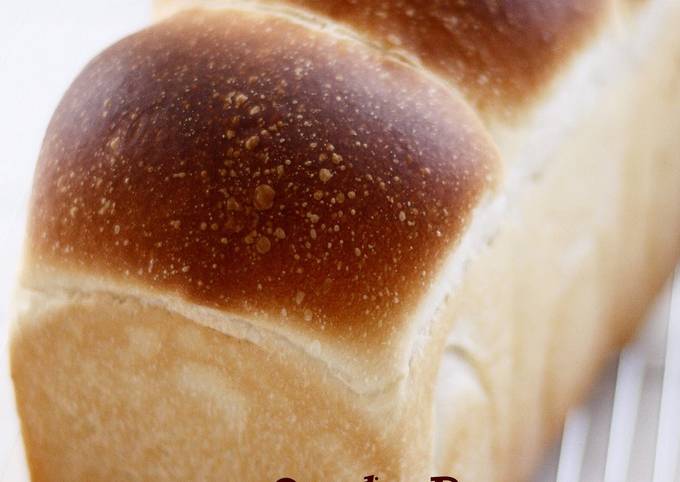Recipe: Appetizing Fluffy and Moist Bread Loaf Using Homemade Yeast
Fluffy and Moist Bread Loaf Using Homemade Yeast. Combine the dry ingredients in a bowl. Add the yeast starter, whey and double cream and mix until well combined. Use a bread machine or kneading device to knead the mixture.
 Allow the yeast to bubble a little before moving to the next step. Move the yeast mixture to a large mixing bowl or a bread maker. The recipe for this beautiful flavorful loaf came from our daughter-in-law, Karen. You can have Fluffy and Moist Bread Loaf Using Homemade Yeast using 8 ingredients and 14 steps. Here is how you cook that.
Allow the yeast to bubble a little before moving to the next step. Move the yeast mixture to a large mixing bowl or a bread maker. The recipe for this beautiful flavorful loaf came from our daughter-in-law, Karen. You can have Fluffy and Moist Bread Loaf Using Homemade Yeast using 8 ingredients and 14 steps. Here is how you cook that.
Ingredients of Fluffy and Moist Bread Loaf Using Homemade Yeast
- It's 250 grams of Very strong bread flour (Golden Yacht).
- It's 15 grams of Skim milk powder.
- You need 40 grams of Sugar.
- You need 5 grams of Salt.
- You need 100 grams of Homemade natural yeast starter.
- It's 100 grams of Whey from drained yogurt.
- Prepare 50 grams of Heavy cream.
- You need 15 grams of Unsalted butter.
Everyone who enjoys a slice of this moist bread asks me for the recipe. It's super used for a sandwich or just served with butter. —Ardath Effa, Villa Park, Illinois In a small mixing bowl, add the yeast and inulin, followed by the warm water. In a large mixing bowl, add the almond flour, psyllium, baking powder, xanthan gum, and salt. The essentials of any bread dough are flour, water, and of course, yeast.
Fluffy and Moist Bread Loaf Using Homemade Yeast instructions
- Combine the dry ingredients in a bowl. Add the yeast starter, whey and double cream and mix until well combined. Use a bread machine or kneading device to knead the mixture..
- After the gluten forms divide the dough into about 10 portions. Add the unsalted butter and start to knead again. Once you see the gluten film forming in the dough, the kneading is completed..
- I normally prove the dough overnight. Form a ball with the dough and put into a container. Prevent from drying and leave to prove overnight. Depending on the temperature you might need to put the dough in the fridge after some time..
- The next morning the proving is completed when the dough has doubled in size. Divide the dough into 2 or 3 portions and form smooth balls..
- Cover with a moistened tea towel or cling film to prevent from drying and leave to rest at room temperature for 20 to 30 minutes. Adjust the proving time according to the temperature..
- After resting, roll out the dough into flat rounds..
- Fold the side towards the centre and press on top..
- Roll up the dough. Seal the end tightly..
- Place the prepared dough into an oiled loaf tin. Press the top of the dough gently to flatten..
- In summer, leave to prove at room temperature for 30 to 40 minutes. When it's cold, use the proving setting of your oven and leave to prove for 1 to 2 hours..
- When the dough rises up to the top of the tin, start to preheat the oven to 190°C. Bake for 30 minutes once the oven is ready..
- Check the bread after baking for 10 to 15 minutes. Cover with aluminum foil quickly to prevent from browning too much....
- After baking, remove the excess stream by dropping bread tin from a height of 30 cm. Remove the bread from the tin and put onto a cooling rack..
- It's moist and soft. You will enjoy the chewy texture. You'll be surprised to find how moist the bread is! Moist and chewy. Make sure to prevent the bread from drying when storing..
In our recipe, we start by stirring active dry yeast together with flour, milk, sugar, and melted butter—the combination of the three things yeast loves most (food, moisture, and warmth) here activates the yeast and "feeds" it, which invites fermentation. In a stand mixer add the warm water, sugar, salt and yeast. Using the dough hook start adding the flour one cup at a time until the dough combines and forms a soft dough. On a floured surface knead the dough until smooth and elastic and form a ball. Making light fluffy bread or bread that is less dense is mostly a matter of using the right ingredients and to some extent the right process.
Comments
Post a Comment